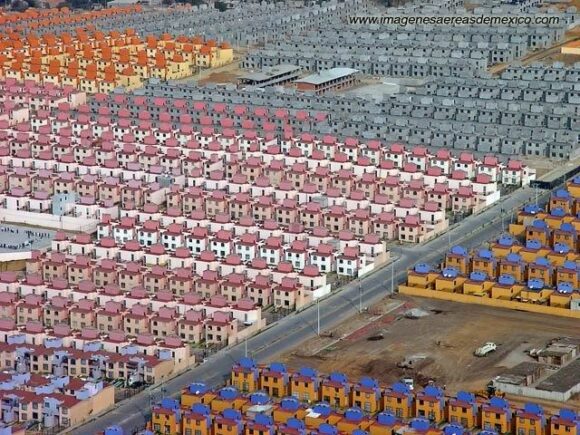We drew attention a few years ago to the issue of Empty houses in Mexico, a problem due in part to on-going rural-urban migration, and in part to the construction of millions of new homes across Mexico. Thirty years ago, there were only 15 recognized metropolitan areas in Mexico, today there are 59.
Poor coordination between the various government departments responsible for housing, services and land development has led to some settlements being authorized even in areas where ownership was disputed or that lacked adequate access to highways or basic services.
Three years ago, a Mexico City news report entitled Desorden urbano dejó en el país millones de viviendas fantasmas claimed that as many as 4 million houses, many of them newly built, were standing empty. Other houses have been abandoned for a variety of reasons, ranging from the death of former owners, or owners moving to other areas, or being unable to keep up with mortgage and loan payments.
News reports claim that as many as 14 houses in a single street are abandoned in some areas, such as the Mineral de la Reforma district of the rapidly-growing city of Pachuca in the state of Hidalgo, causing problems for neighbors.
Now, the Mexican Workers’ Housing Fund, Infonavit, has set itself the target of reclaiming 30,000 abandoned houses this year. Infonavit has funded hundreds of developments with small, cookie-cutter houses, across Mexico. Members of Infonavit can access a series of housing-related mortgage products, to buy or remodel a new or existing home.
Starting last year, Infonavit began to rescue abandoned houses, renovate them and then auction them off to its members. Initial success was limited, with only about half of the repossessed homes being sold on, but in the first few months of this year, Infonavit has successfully sold off 92% of the first 3,000 houses it has recovered.
This year, Infonavit plans to auction off homes in Chihuahua, Nuevo León, Tamaulipas, Hidalgo and the State of México.
Related posts:
- Suburbia in Mexico: Alejandro Cartagena’s images of Monterrey
- The urban regeneration of Barrio Antiguo in Monterrey
- Changing urban landscape: the rapid rise of low-income subdivisions
- A case study of low-income housing on the urban periphery
- Vecindades, Mexico City’s inner-city slums (Jul 2010)
- Nezahualcoyotl, an irregular settlement which grew into a monster (Jul 2010)
- Informal settlements or “colonias populares” in Mexico’s cities
- Repainting the walls of Palmitas in Pachuca leads to reduced crime
2 Responses to “Reclaiming empty houses in Mexico”
Sorry, the comment form is closed at this time.

Very interesting. Just to the west of me a gaggle of Infonavit houses is going up, and I’ve been wondering just who would want or be able to live there. Had no idea there was such an overage(what’s the opposite of shortage) in Mexico. And of course I’m always sad to see they don’t even leave a handkerchief of green around those houses. Not just for aesthetics and enjoyoments, but I;m certain it would be healthier for those who live there. Phyllis
Thanks for your comments, Phyllis. You make a good point about green space, and coincidentally I’m planning to write a short piece about green space in Mexico City before too long. You are absolutely correct that green space not only looks good but is also associated with better health and more enjoyable lives. Your own oasis of greenery is magnificent and even the Infonavit houses to the side won’t be able to change that! Best wishes, Tony